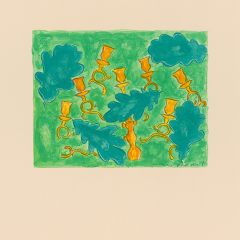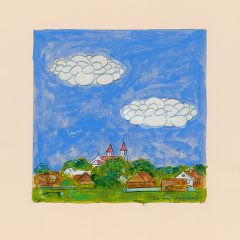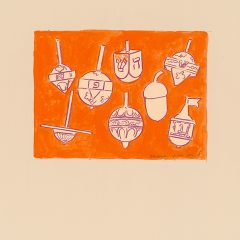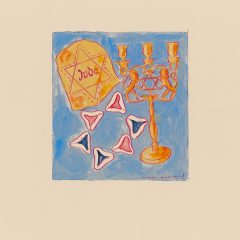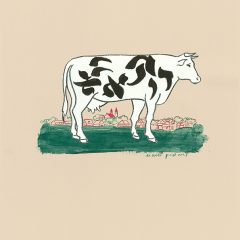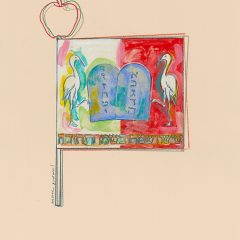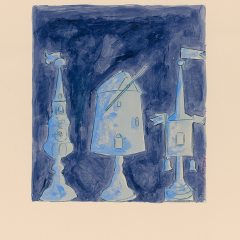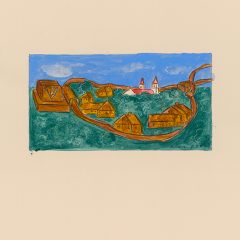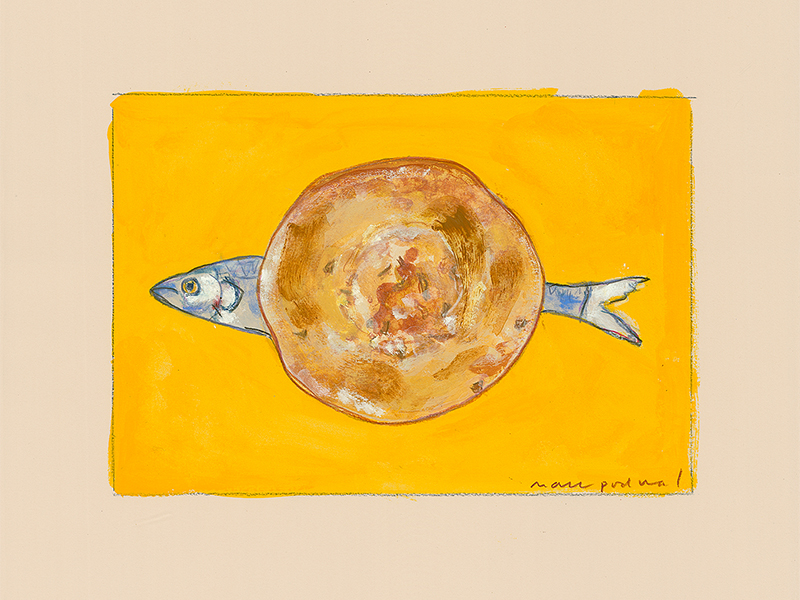
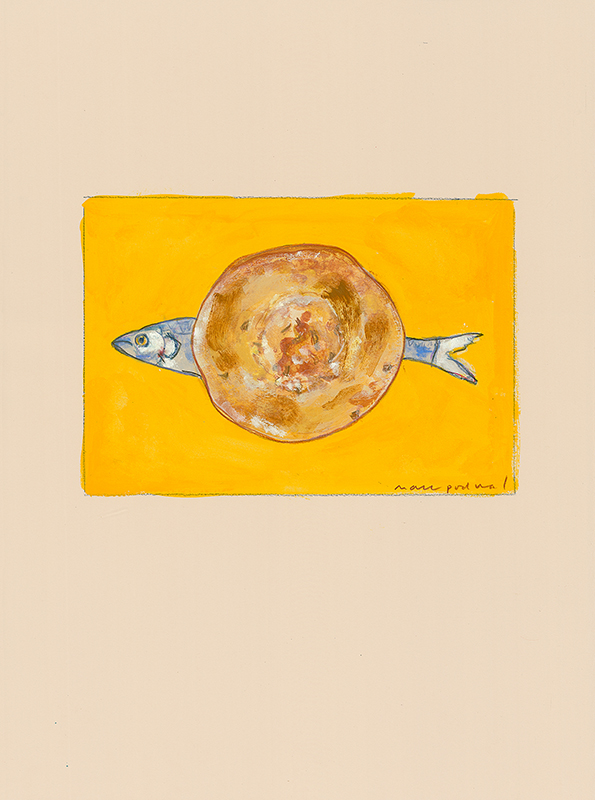
“Herring on a Bialy” by Mark Podwal. Image courtesy of Mark Podwal
(RNS ) — Mark Podwal’s drawing “Herring on a Bialy” portrays the salty fish sandwiched inside the roll invented in Bialystok, Poland, for what it was: shtetl food.
Yet this straightforward acrylic and colored pencil drawing of the humble forage fish has recently hooked Hollywood royalty: American actor, writer, producer, director and comedian Mel Brooks.
A patient of Podwal, who in addition to being an artist is also a dermatologist, Brooks was drawn to the work because his ancestors sold herring in Danzig, Poland.
[ad number=“1”]
That a symbol of Jewish folkways would command attention in Hollywood reflects the ways many Jews think about their identity.
In 2013, 14 percent of respondents to the Pew Research Center’s study on Jewish Americans said eating Jewish foods was an essential part of being Jewish.
If there are religions defined almost wholly by faith and doctrine, Judaism, most people would agree, is not one of them. To be a Jew is to identify with a complex mélange of signifiers, among them faith, the Holocaust, food and a certain sort of humor.

Filmmaker Mel Brooks and artist Mark Podwal. Photo by Luz Santiago
Podwal, 72, has managed to create artwork that captures elements of Jewish communal culture and custom and been featured at New York’s Metropolitan Museum of Art and London’s Victoria and Albert Museum.
He has drawn especially high praise from intellectuals who have thought and written about the Holocaust, or the Shoah. Novelist Cynthia Ozick has described Podwal as “Master of the True Line — one of those startling souls — who can imagine, through the power of a unifying eye, connections so new that they shake the brain into fresh juxtapositions of understanding.”
Elie Wiesel wrote of him: “He captures what death has forgotten to take.”
In 2016 Podwal, who calls himself a “non-observant Orthodox Jew” (he celebrates the religious holidays and says he views his drawing as a form of prayer), visited his mother’s birthplace, the Polish town of Dąbrowa Białostocka.
[ad number=“2”]
In 1941 the Nazis burned down the village, which was 70 percent Jewish. No Jews live there now. That tragic end of Jewish life moved Podwal to create an 18-piece series of drawings titled “Kaddish for Dąbrowa Białostocka.” (“Kaddish” is the Jewish mourner’s prayer; the number 18 is the total numerical value of the Hebrew letters “chet” and “yud” that together spell “chai,” or “life.”)
One piece in the “Kaddish” series portrays a menorah partly covered with oak leaves (Dąbrowa means oak forest). Another shows a white stork, a common sight in Poland, nesting atop a Jewish spice box, used in a ceremony marking the end of the Sabbath.
A third, more whimsical and the favorite of Brooks, is an acrylic and colored pencil drawing of a sandwich made of herring, an Eastern European Jewish staple, on a bialy: a thinned-down, garlic-garnished bagel with no hole, named after Bialystok, a city near Dąbrowa.
The series, which explores Jewish ritual objects and culture in playful ways, will be on view this fall at the Yiddish Book Center in Amherst, Mass.
In a twist that surprised and pleased Podwal, it has also attracted attention in Poland; a showing will open soon at a cultural center in Bialystok.
“It’s very moving that this work is having a life of its own,” Podwal said of its upcoming travel.
Now a special copy of the herring sandwich is in the collection of Mel Brooks.
Brooks, who is 91, first saw “Herring on a Bialy” in Podwal’s office.
“I just couldn’t get over it,” Brooks said in a phone interview from his Los Angeles office while explaining that his grandfather had sold herring in Poland.
[ad number=“3”]
“I said, ‘That’s it. That’s our family crest. It’s everything there is to say about the history of the Kaminskys.’”
Brooks, born Kaminsky, says his grandfather, Avram, was in the herring business with his brother, and the two continued to operate a herring warehouse on New York’s Lower East Side after they immigrated.
“Our family was into herring two generations before I was born, so I guess they expected me, as a good little Jewish grandchild, to carry on the herring tradition,” he said. “Unfortunately, I skipped over it and went into show business.”
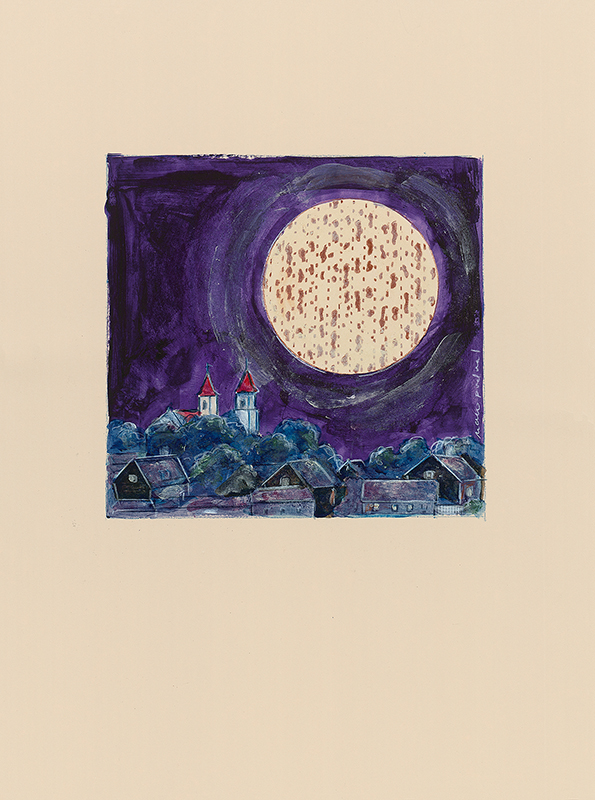
“Matzoh Moon Over Dabrowa Białostocka” by Mark Podwal. Image courtesy of Mark Podwal
The Kaminsky brothers, whose business was on Essex Street on the Lower East Side, once owned 100 pushcarts.
Brooks also has a more than passing acquaintance with bialys.
“Bagels were, like, sophisticated,” the comedian said. “Bialy was more common in our family. There was more to it. You didn’t have a hole. You had the whole bialy. You didn’t feel cheated.”
None of his films ever dealt with herring, however, as the food is “too sacred to exploit,” Brooks said. “It kept the family going for 300 years.”
Podwal was happy to present Brooks with an archival print — called giclée — of “Herring on a Bialy” and he is clearly happy to have it. It is possible, the artist suggested, that the filmmaker’s appreciation of it may extend beyond family history.
Although the director of “Blazing Saddles” does not flaunt his learning, the artist said, “He easily understood the meanings and messages in my works, which are at times subtle.”
For instance, he said Brooks has demonstrated extensive knowledge of the historical anti-Semitic events depicted in Podwal’s series “Terezin Portfolio,” as well as pieces in his “Mozart and Prague” series.
In any case, the artist said, “It’s very moving that this work has continued to have a life of its own.”
(Menachem Wecker is a freelance writer based in Washington, D.C.)

